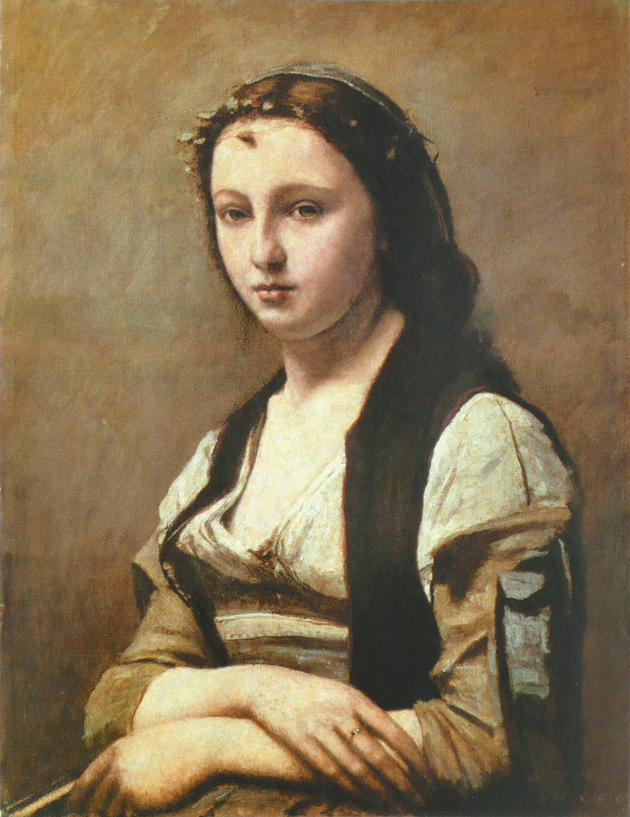“Il étonne lentement”—“He astonishes slowly”—wrote Baudelaire in his review of the Salon of 1859 about the paintings of Camille Corot (1796–1875). “You must open yourself to his style,” he continued. “There are no flashy tricks [papillotage] in his work, but only an unerring, rigorous harmony.” Thus the great critic expressed his admiration for this singular, unpretentious artist. In the mighty concert of French painting from David to Cézanne, Corot’s voice is a silvery one, quiet yet unmistakable, dreamy but with tenacious concentration. He was not one of the dominant leaders of a stylistic school, yet gained a stature of his own alongside theirs.
Gazing at a work by a great master he confessed, “He is an eagle; I’m only a skylark tossing off little songs into the gray clouds.” Within his clamorous century Corot was one of the gentle poets—like Alfred de Musset and Eduard Mörike—whose works are touched by a reticent melancholy.
His contemporaries knew him as a landscape painter. In the shadow of the Barbizon School, of Courbet and the Impressionists, “Père Corot” (as he was affectionately and a bit patronizingly known) elicited from nature, from trees and water, walls and stones, his own unmistakable effects. He struck a balance between the topographic and the idyllic, between construction and invention. In a lovely essay on Corot, Paul Valéry wrote, “From the animated earth, from tree and bush, from buildings and all the daylight hours he knows how to draw a magic that approaches music more and more closely.”
He developed slowly. In 1825, already almost thirty years old, he went to Rome not on a scholarship from the Villa Medici or as a winner of the Prix de Rome, but rather with the financial support of his father, who accepted his son’s strange choice of profession with skepticism but without resistance. Corot thus remained untrammeled by academic constraints or the need to copy either the ancients or the great Italians. He never set foot in the Sistine Chapel; nature was his school.
He painted the rural landscapes surrounding Rome on small or at the most medium-size canvases. He built up their palette from a few earthy tones: brown, ocher, muted green. Here and there we catch sight of enlivening figures: peasants, shepherds, country folk. Sometimes—as in his view of the ruined Roman bridge at Narni—there is a reminiscent flash of the classical landscape or the unforgettable Claude Lorrain, but always overlaid with an idyllic mood of rural solitude. Greatness and heroics were never Corot’s themes.
Like many artists from northern Europe, he had a receptive eye for the popular culture of the South, but never chose to portray, say, the merry goings-on in a Roman osteria. Instead, he painted isolated figures on small panels, figures who cast their shadows onto the walls of bare rooms: an Albanian woman dressed in a holiday costume, a girl from Papigno with black hair and a saucy red apron. There is not a hint of the picturesque or of folkloric charm. The figures are as still as Corot’s landscapes. But then we happen upon an unexpected amplification: a Benedictine monk in a heavy habit that encloses his body like a bell, with a sack and a pilgrim’s staff, reading his breviary. There’s nothing sanctimonious or Nazarene-like about him; he symbolizes a withdrawal from society and public life. Corot had discovered a basic motif to which he would return again and again, right up to his final days.
When someone remarked to Edgar Degas that Corot was an expert at drawing trees, the often contrarian Degas replied, “He’s even better at drawing figures.” We have had many occasions to admire the landscapist. Now the Oskar Reinhart Collection in Winterthur, Switzerland, is devoting a small, select show with the lovely title “L’Armoire secrète” to the less well known painter of unassuming, solitary figures. “The Secret Cabinet” plays on the fact that especially in his last years, the artist created these figures in what amounted to private silence, hardly showing them publicly and presenting them at the Salon only as a rare exception. They are among the most taciturn and puzzling paintings of the nineteenth century.
Such an exhibition could not and should not be large. The short, scrupulously designed catalog lists twenty-three paintings—not all of them included in the show—and a few drawings. They are exhibited in three modest rooms, against walls covered in gentle green or light blue material, hung at pleasing intervals so that they achieve their effect calmly, as befits Corot. If one feels the need for a moment of distraction, one can admire his landscapes in the permanent collection, among them the priceless Bridge of Mantes once owned by Degas.
Advertisement
With few exceptions, there are mainly women in these paintings of solitary figures, including a small, demure picture of Corot’s sixteen-year-old niece Claire in a chaste white dress with her graceful hands half hidden by her fingerless gloves. Although the sitter is in the bloom of youth, she stands before a melancholy evening sky. Like all Corot’s female figures, she seems more spirit than flesh. Here also are the mysterious readers, usually sitting outdoors beneath trees and among flowers, each bending in rapt attention over her small book on whose pages not a single letter can be made out (see illustration on page 10 of this issue). They are clad in Italian folk dress, wear no jewelry, and are by no means decked out for some social occasion.
An early picture from 1845, which goes by the curious title La Muse de Virgile, is a Romantic echo of Raphael’s Madonnas but transforms his Mariolatry into a belief in the purity of poetry and the innocence of nature. In another painting, the Petite Liseuse (the Little Reader), a herd of sheep grazes in the background. Are we meant to think of Saint Genoveva (as the catalog suggests with zealous iconographic learning)? Should the paintings not rather remind us that Corot was an enthusiastic reader of Theocritus and that here he brings bucolic poetry into play? The visitor can admire these charming, self-absorbed women and girls, find them delightful, but cannot grasp them sensually. The erotic remains elusive. Although Corot infrequently painted female nudes, there is an example here: a small, secretive picture of a nude with a greedy gaze of frightening, feline sensuality. The undressed female body unleashes fear. In the context of the Winterthur exhibit this Marietta, painted in Rome in 1843, represents a jarring break, a crack in the idyll.
The high point of the show is La Femme à la perle from the Louvre. The title is eloquently misleading, for what gleams on the sitter’s chaste brow is not a pearl but only a leaf. Again we have a picture of a Parisienne—we even know the model’s name—dressed as an Italian peasant, but above all, it is a daring metamorphosis of the most famous portrait of the Italian Renaissance, Leonardo’s Mona Lisa. We know Leonardo’s portrait as a work shrouded in legend, inviting travesty, mystified by exegetes. Corot’s portrait is the purest echo of that masterpiece.
His circumspect approach does not subvert Leonardo’s greatness. Here too, he remained the lark next to the eagle. He has adopted everything from his predecessor—the shadows playing about the eyes, mouth, and cheeks, the hands laid one upon the other—but the appearance of La Femme à la perle seems suffused with the naturalness of Corot’s landscapes. She is a Mona Lisa who has read Rousseau.
The older Corot became, the more astonishing and strange grew his figures. While he continued to paint silvery, enchanting landscapes from la France profonde, his figure paintings show melancholy odalisques or an Algerian woman dressed in a burka. The dream of the riddle that is woman acquires a spectral cast. In 1874 he returns to the primal motif of the monk, the symbol of flight from the world and society. We see an old Capuchin playing a cello and are reminded of Rembrandt’s representations of old men from the Bible. But Corot’s picture neither refers to an iconography nor corresponds to reality. It is nothing but the artist’s dream of escape, music, and approaching death.
Corot’s “Armoire secrète” is the fourth such exhibition at the Reinhart Collection, following “Manet Meets Manet: Separated, Reunited” (on Manet’s Au Café), “Venite, Adoramus: Geertgen tot Sint Jans and The Adoration of the Kings,” and “Eugène Delacroix: Reflections: Tasso in the Madhouse.” It comes at a time when Corot’s noisy and prurient contemporaries, such so-called pompiers as Jean-Léon Gérôme and Alexandre Cabanel, stride onto the exhibition stage with aplomb and meet with wild enthusiasm from a public greedy for visual entertainment.
All the more important that this small, beautiful show remind us of one of the quiet voices of the great century of French painting. When Corot was asked what heaven would be like, he said, “I hope one can paint there.”
This Issue
April 28, 2011




